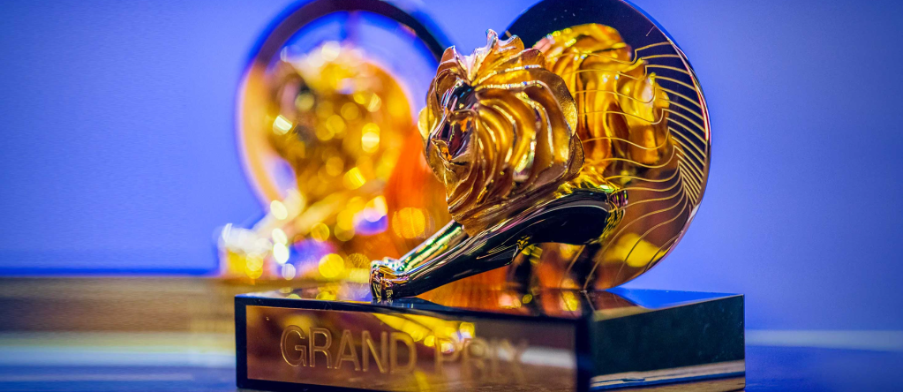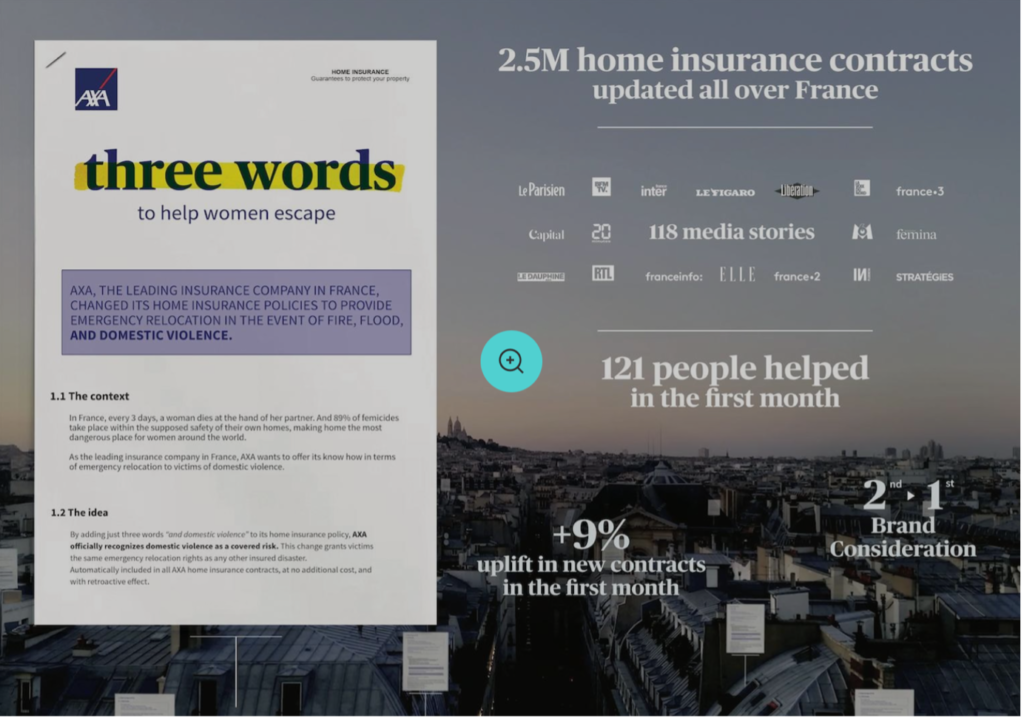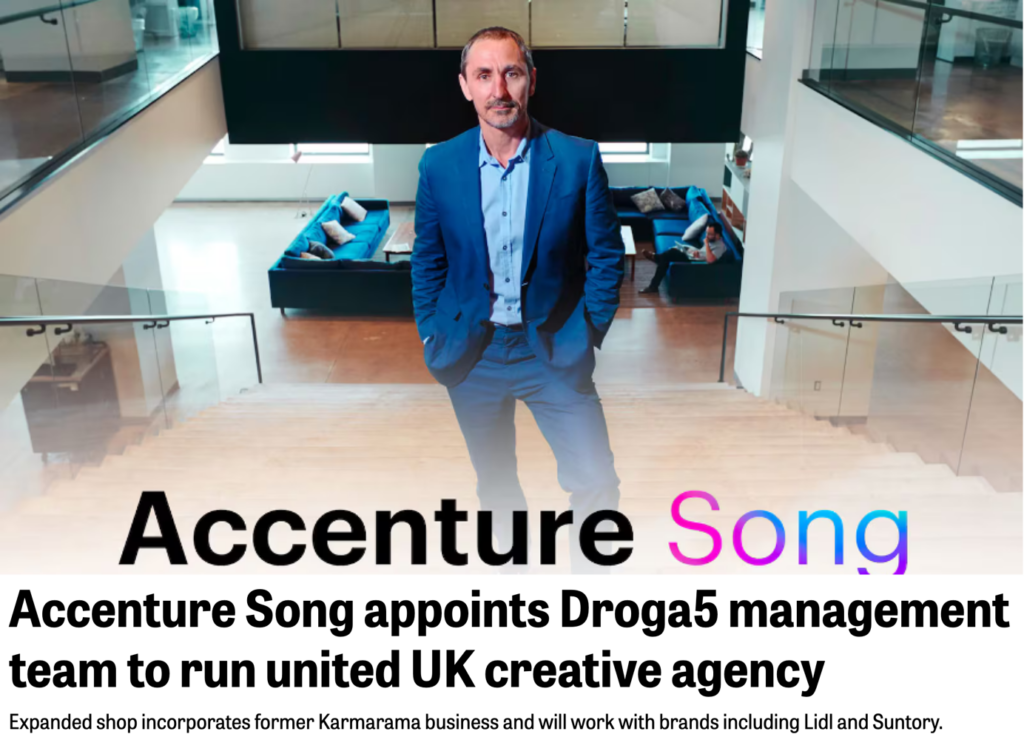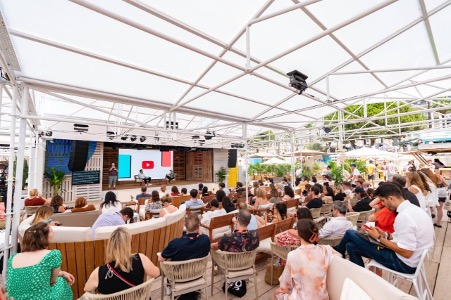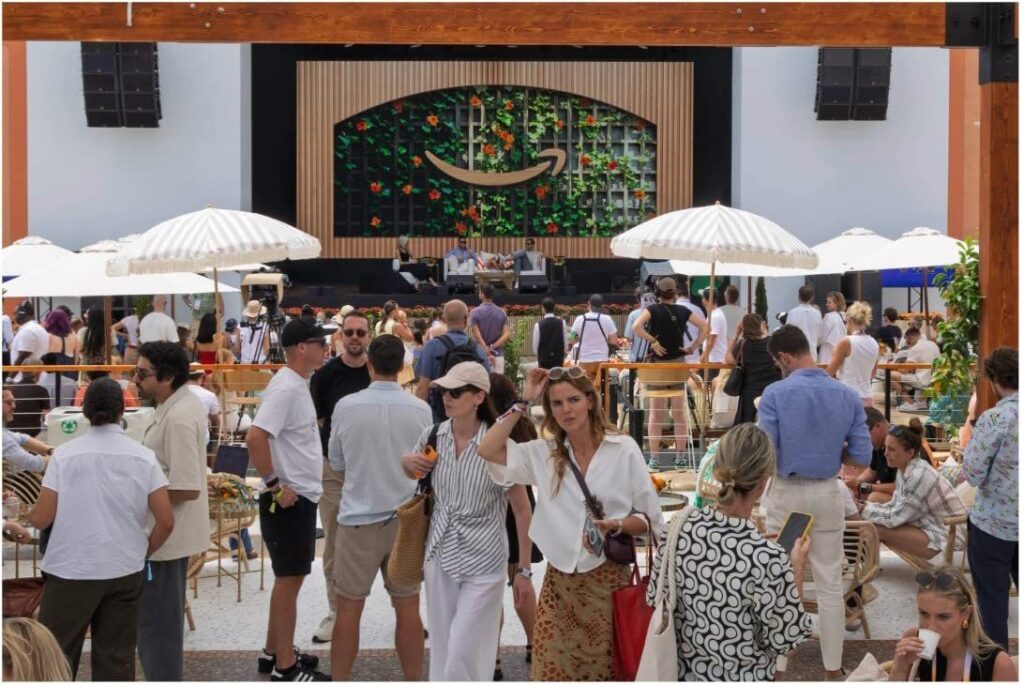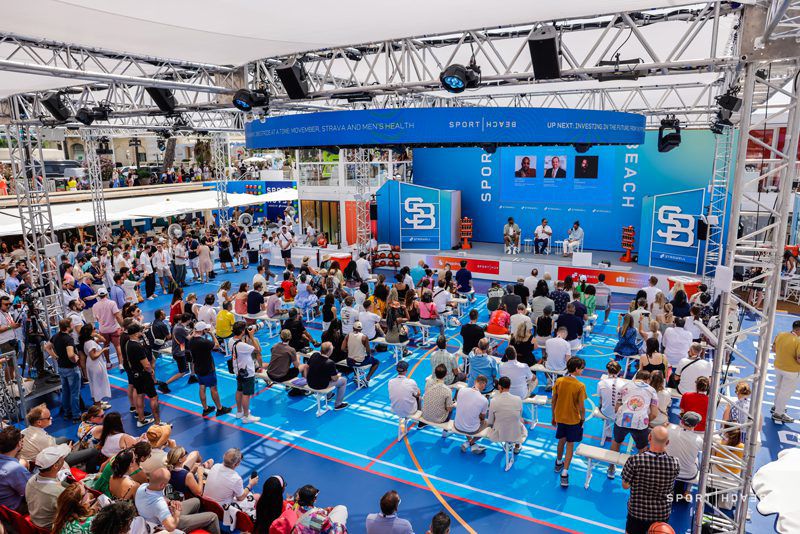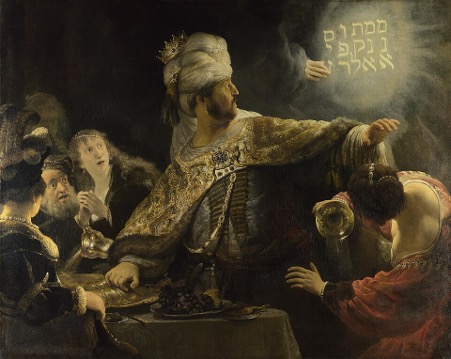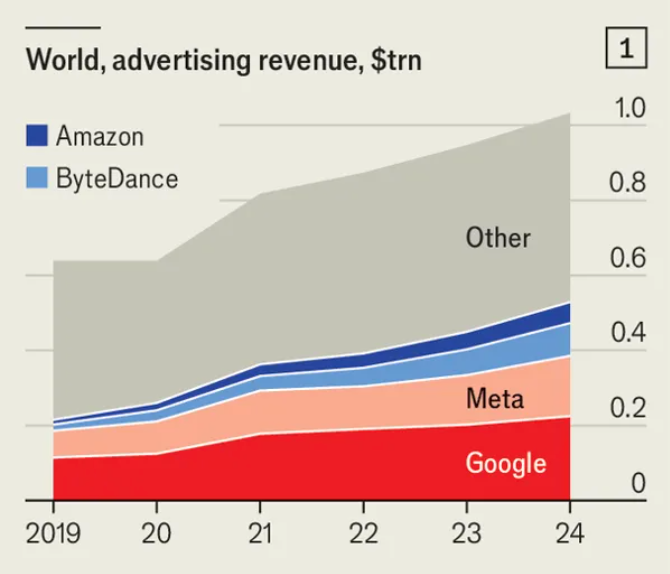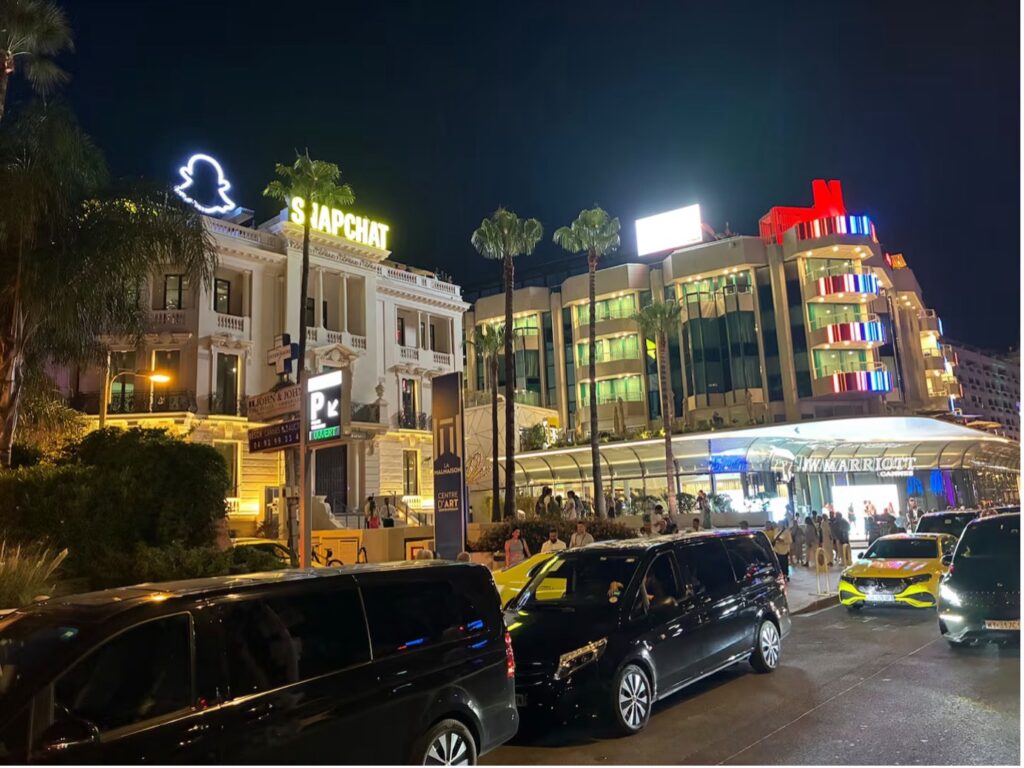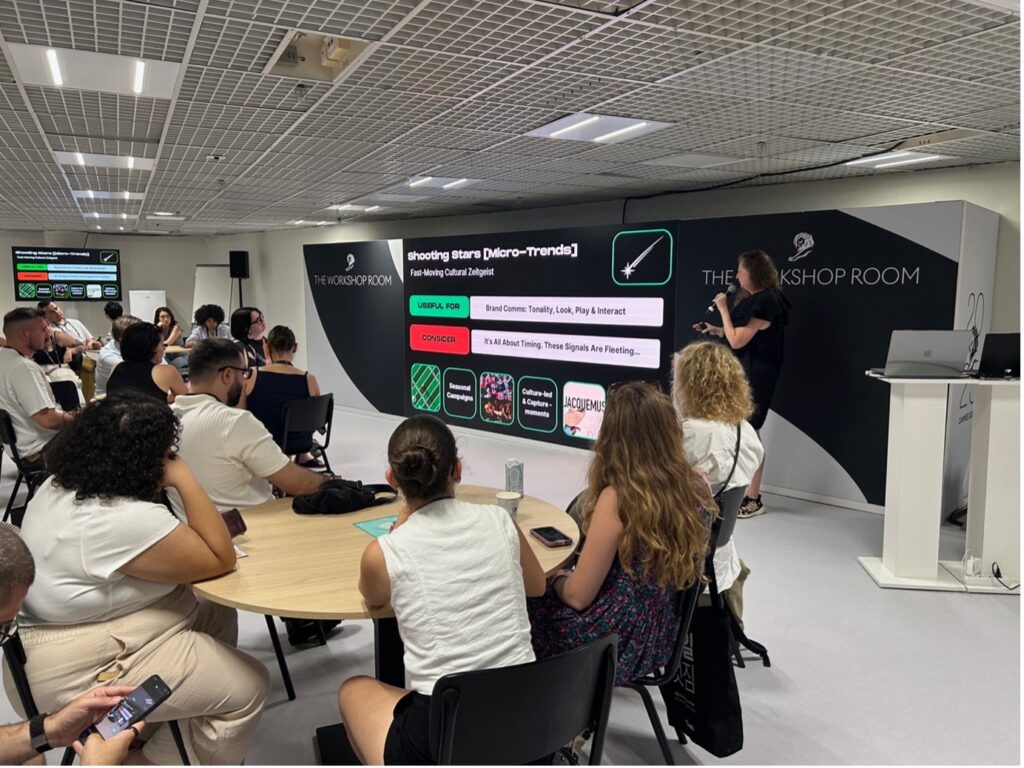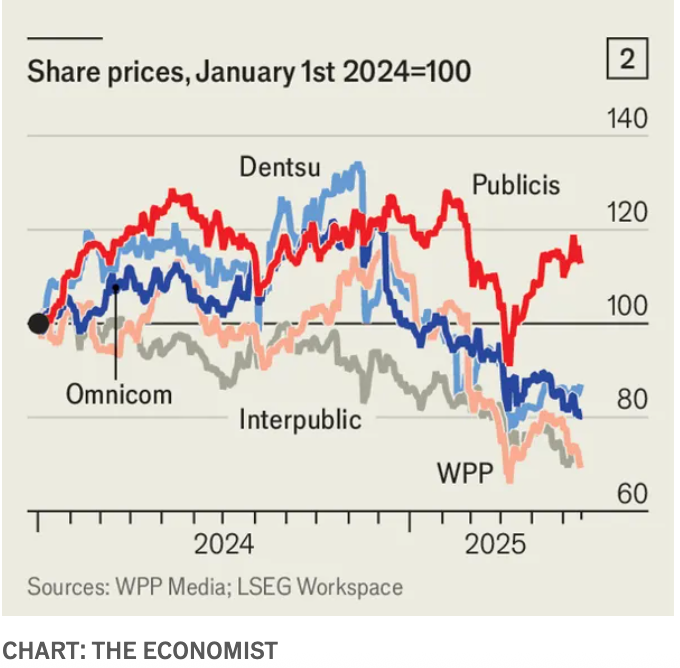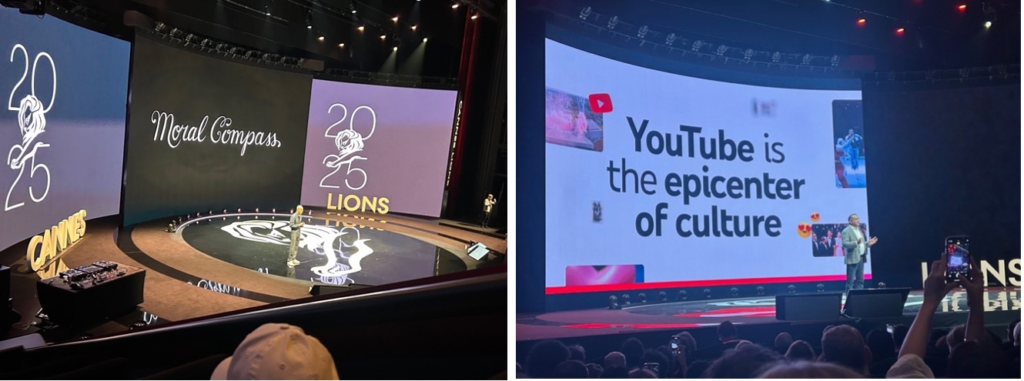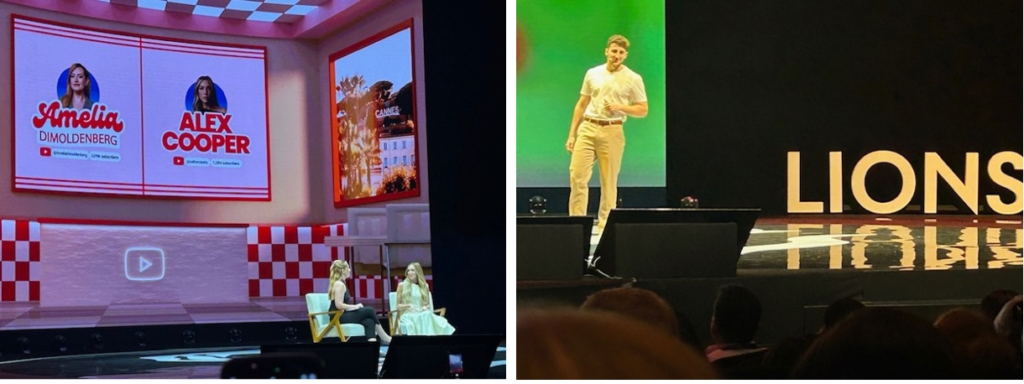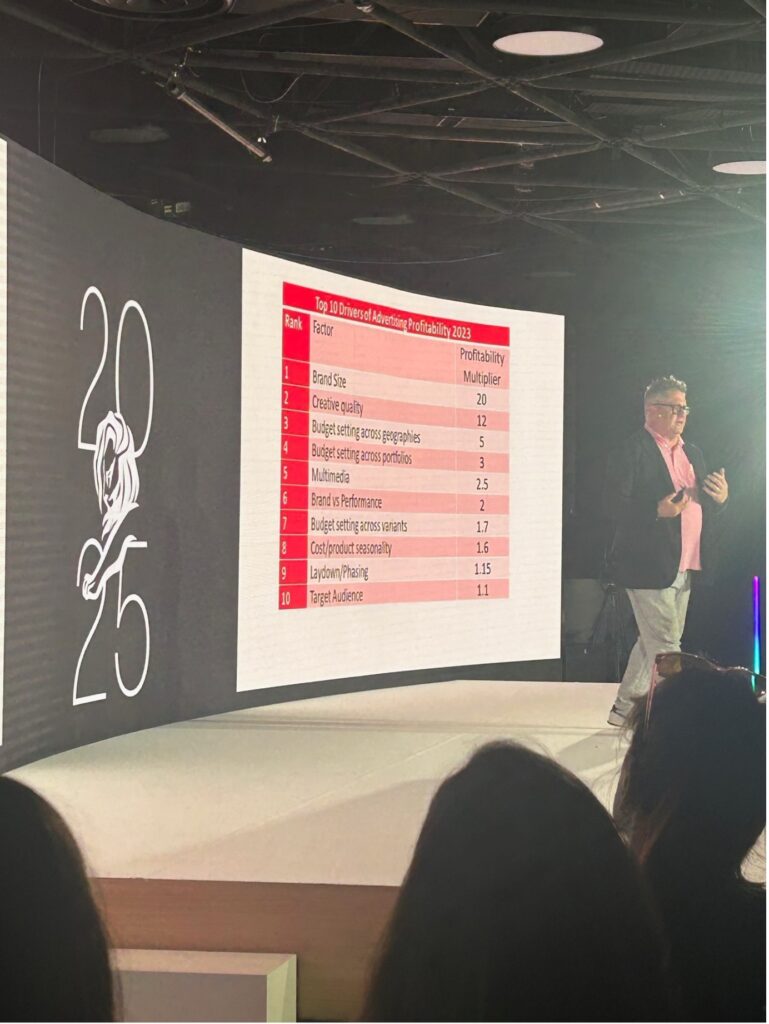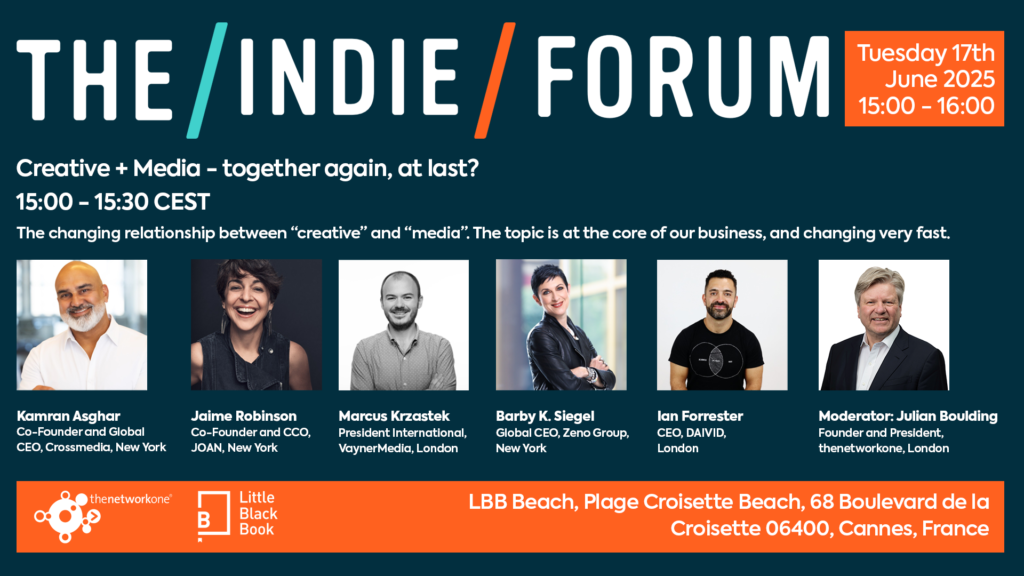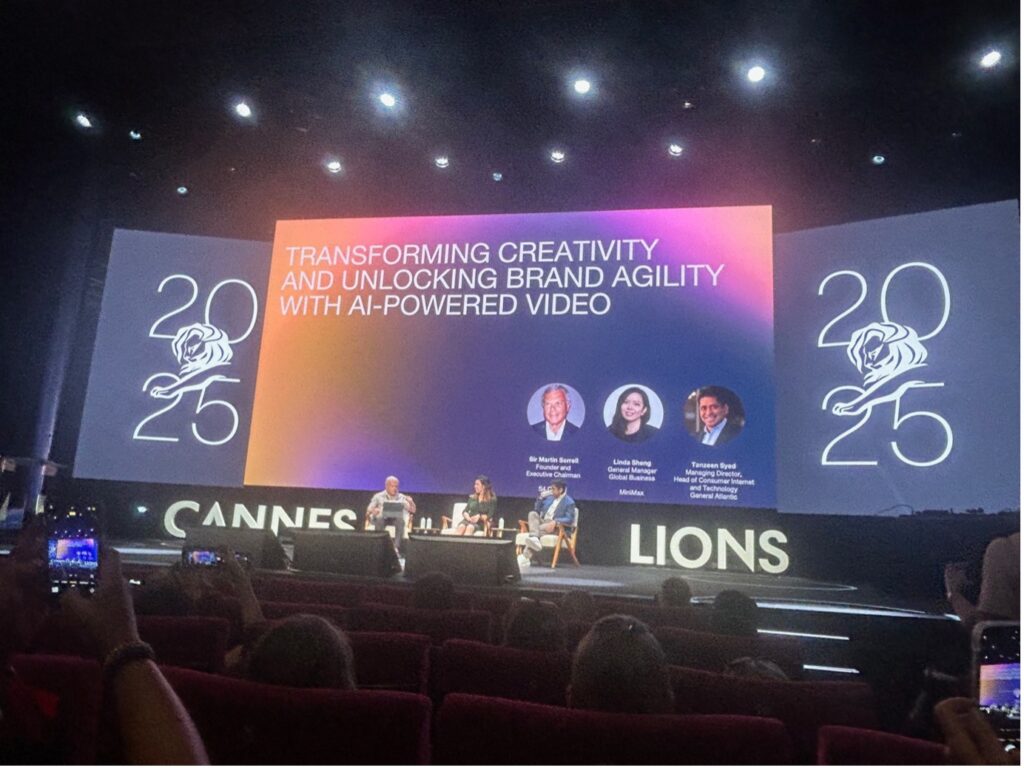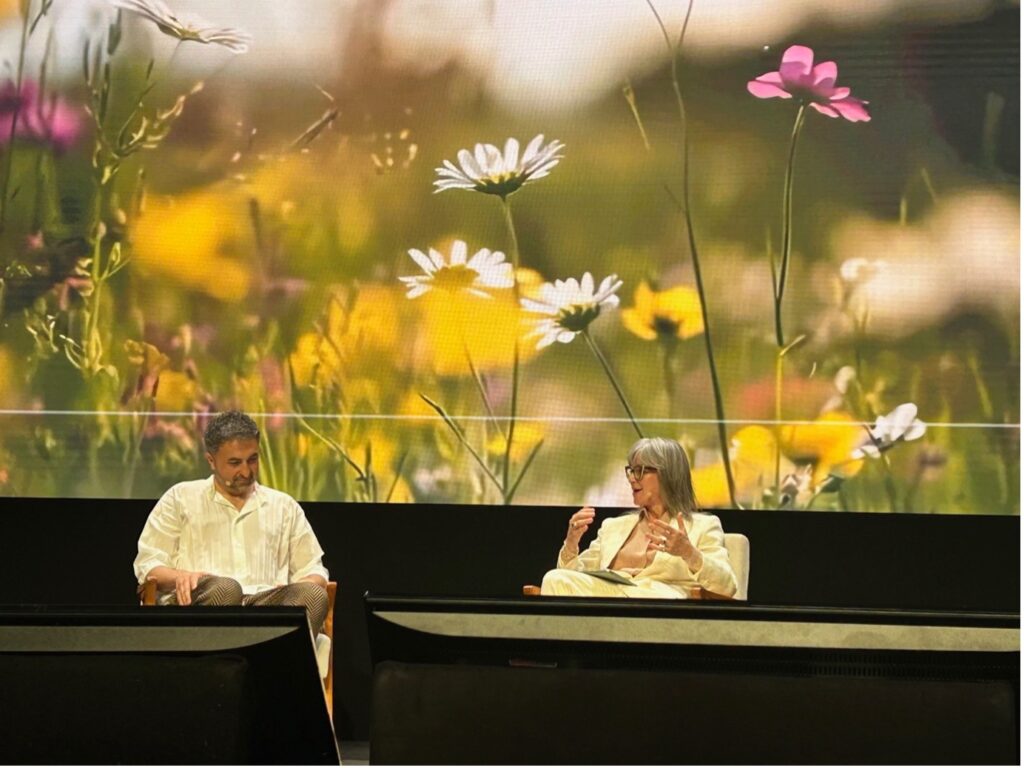Julian Boulding’s Cannes Review 2025
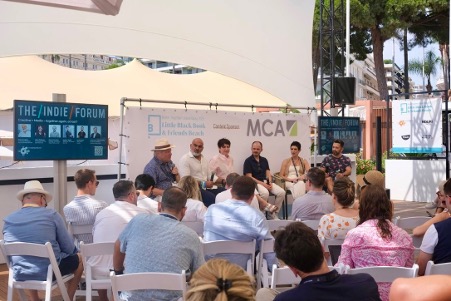
The Cannes Lions Festival of Creativity, which took place from 16th– 20th June, is still our industry’s biggest and most important global gathering.
Beyond the official programme of talks, events and awards in the Palais des Festivals, there are now more than 1000 official, organised, private or unofficial fringe events featured in the infamous Ben’s Party List.
Cannes is organised chaos on a grand scale.
Because the US participants, who dominate the town these days (at least, financially) like to be home for the weekend, the Lions is now effectively a four day event, from Monday to Thursday.
The smart set arrives on Sunday and by Friday morning, the Circus has left town. So it’s now a very concentrated experience – with little time for reflection or relaxation – unless you are lucky enough to be invited to Gemma and Dan’s Nurture lunch on the Ile des Lerins!

For all these reasons and more, we take a week or so after the event, to consider what we have seen, heard and read – and draw some conclusions, about the state of marketing and communications generally, and the agency world in particular.
Whether or not you attended Cannes yourself this year, we hope you enjoy thenetworkone Cannes Review 2025.
Cannes Lions
Every year, we start with a reminder that the Cannes Lions is still an awards festival, and a look at “the work.”
The main purpose of entering creative awards shows is to motivate and retain your existing young talent; and to attract new young talent.
This is still a significant business: with 26,000 award entries and a minimum cost of around US$ 500 per entry, the Lions is looking at $13 million in awards revenue. But compare this with Apple’s annual revenue of around $390 billion – Apple makes $13 million, every three seconds.
Some traditional agency networks still believe that more is better, and pad out their awards entries with submissions to makeweight categories like “Entertainment for Gaming” (327 entries), “Creative Business Transformation” (261 entries) or “Luxury” (181 entries).
Does this mean that the awards (the Lions) are no more than a sideshow? Well, no, it does not mean that.
They are Cannes’ reason to be – like the Oscars and the Palmes D’Or in the movie business. They act as a focal point. A massively important brand asset for the creative industry. A reason to come together. Without the Lions, Cannes would be like the Consumer Electronics Show in Las Vegas, or DMexco in Germany. Would anyone who has a choice, really prefer go to one of those?
So – Who won? What won? Why?
Opinions are subjective, but for most people I spoke to, 2025 in Cannes was not a great year for creativity.
There was no stand-out campaign, sweeping seven or eight Grand Prix. The two biggest winners were:
- Publicis’ work for Axa Insurance, which won three: the ‘Titanium’ (multi-channel) Grand Prix, plus ‘Direct’ and ‘Creative Business Transformation’.
It’s built around an observation that home insurance pays out for alternative accommodation in case your home becomes uninhabitable due to fire or flood, but not if you have to leave due to domestic violence. This often means the victim has nowhere else to go, so has to stay with the perpetrator. Axa adds three words to its policies: “and domestic violence”.
Great insight, Great solution, Grand Prix. Let’s just hope the take-up has increased since the entry was prepared: 121 people were helped, out of France’s estimated 1 million cases of domestic violence.
- FCB’s work for the Chicago Hearing Society, which also won three: Brand Experience and Activation, Design and Digital Craft. This is built around establishing a practice in subtitling films and other audiovisual content to include more information than simply the words being spoken. For example – tone of voice, who is speaking, SFX.
This helps people with auditory difficulties. It’s a good idea, but doesn’t Netflix already do this?
Looking for trends, we can observe:
- A roughly 50-50 balance between “purpose-driven” and commercial work.
- A large number of ‘sequels’ to previous winning work: notably Dove, but also Apple. (It’s the same with Hollywood movies – is originality too risky?.)
- Very little humour on display: only 2 GP winners were even trying to be funny. Risk-averse attitudes diminish creativity.
- Only 3% of entries won a Lion. So 97% did not. Cannes is keeping the standard high, so winning a Lion really means something.
It also means that on average, you need to pay for 33 entries to have an even chance of winning one prize.
- 80% of Grand Prix’s and 80% of Lions were won by Holdco agencies. Indies won around 18%.
- Most Indie winners were large, multi-location agencies: Serviceplan, Gut, Wieden + Kennedy, Edelman. Artplan, Rethink, VCCP, Special Group.
- No other Indie won more than three Lions. For comparison, DDB won 112 Lions (excluding those which were subsequently disqualified for cheating).
- What is more striking is the greatly reduced presence of winning entries from Asia, Africa and the Global South. No GP’s at all went to Japan. India and China won each (both submitted by American agencies). None went to Africa. Since these four locations account for two thirds of the world’s population, this says a lot.
- Outside the holdco home base countries UK and France, only two GP’s went to European countries (one to Germany, one to Denmark).
Hopefully these geographical swings can be reversed, or Cannes will risk becoming an Anglophone echo chamber. Automatic free entries for winning work from credible local or regional award shows might be a good start.
Also: no-one enters ads for the awards competition these days, it’s all case histories.
A case history is essentially a sales pitch to an awards jury. If you’ve not seen Zulu Alpha Kilo’s take on this, swap your KitKat for a phone and take a look.
This might be a radical thought, but wasn’t Cannes better when the juries were judging what the public audience actually saw?
Finally, a quiz question.
Taking all the agencies that won a Lion or Lions at Cannes this year: how many agency names include the name of the founder (or anyone else) who is still alive?
Go on, there must be some. After all, it’s a people business, right?
Obviously not Ogilvy or McCann, they passed away decades ago.
Bob the Robot? He is still alive, a Glasgow street performer but not connected with the Finnish agency.
Edelman? Getting closer, but it was named after Richard Edelman’s father, Dan, who is no longer with us. Tombras? Same deal.
Wieden + Kennedy? Or Conran? Nearly right.. but they all passed within the last five years.
L&C New York and VCCP in London come close – at least they are the initials of living founders, if not actual names.
The answer is – only one: Droga 5. Coincidentally, founded by David Droga, who led the division of Accenture which decided to do away with the names of the other creative agencies in the group and all them all Accenture Song. We’ll give Mr Droga the Animal Farm award, for recognising that while all animals are equal, some are more equal than others.
Today’s agencies are called Gut, Motion Sickness, Slap Global, Talented, Rethink, Artplan and Serviceplan, Special, Uzina, Bear meets Eagle on Fire (that must be AI)..
Is this smart?
We used to be a people business.
What everyone wants today is personal contact. What they get is personalised contact. This is not the same.
What happened to us?
Perhaps we’ll give the prize to a terrific little indie agency from Mexico, who won a Lion in the Film category.
Their name? “Anonimo.”
Cannes – beyond the awards
Let’s get real. “The work” is only on show in the Palais des Festivals, where the official talks and the awards shows take place – and 90% of industry people present in Cannes don’t even have a ticket for the Palais.
These days, most of the action is outside: on the “beaches”, the yachts, the villas, the hotels, the apartments on the Croisette.
So out in the daylight, who’s selling what? And who to?
On the big stages inside the Palais (the ones with the best sound systems and the largest screens), the creative tech companies and the biggest agencies (holdcos and large indies like Serviceplan, Wieden + Kennedy, Edelman and VCCP) are there to talk to their current and future human talent: the “Young Lions,” with free invitations or heavily discounted official passes.
Life outside the Palais
Let’s do what we all do in Cannes, where my step count is over 20,000 a day, and that’s without the 6.30 am jog with Mo Farah, that my younger colleagues recommended:
Let’s take a walk along the main beachfront drag, the Croisette.
Most people attending Cannes will spend their time here. We used to gaze at the sand and the sea, but as these are no longer visible, let’s talk about the pre-fabricated structures which now obscuring the view.
“On a clear day, you can see the sea”
It’s interesting how each one expresses the brand personality of its owner.
Since they too are pitched at Young Talent, I asked my twenty-something colleagues to review the different “beaches.” Here are their evaluations:
Google/YouTube:
“Exclusive” – hard to get an invite and even harder to take your plus-one for moral support. You will meet some YouTube stars at (or just past) the peak of their influence. A quality experience, but don’t bring your friends.
The problem is, “exclusivity” is yesterday’s value. A bit like the way Google is yesterday’s brand, now that Gen Z gets its info from Tiktok, Instagram and Chat GPT. YouTube’s Veo3 is cool tech but does it really offer anything that Firefly doesn’t?
Meta:
“Focussed” – easy to get access, if you have an official Palais pass. That might not sound cool, but see above re who has a Palais pass. Yes, it’s Meta’s demographic.
Products on sale include the glasses that record sound and video on demand and respond to voice commands. Nice food and drink, something for everyone and an OK place to hang out.
Amazon:
Free, accessible, quality content (speakers), a large space with no queues. Not remotely sexy, but super-efficient, functional, relevant and no BS. A nice AI demo, where you could design and create and take away a inexpensive fragrance, especially created for you. Chanel it is not, but hey, it’s affordable and no hassle. Yup, that’s Amazon.
Alfie’s Personalised Fragrance – created by Amazon
Tiktok:
“Cool,” literally – a nice garden setting at the back of the Carlton, friendly and welcoming, lots of iced coffee (only served with re-useable cups), a pleasant community space for creators and above all – the BEST AIR CONDITIONING on the Croisette. With 32 degrees centigrade temperatures outside, they had their finger on the pulse (and it was still beating). No Chinese owners in sight. Perhaps they were on the Huawei beach in Xiamen, gazing out to sea, towards the island of their dreams.
Or maybe not – the Japanese were equally absent from Cannes this year. Could it be they can’t afford the airfares?
Other prefab structures included:
Pinterest – overcrowded and underwhelming
Linked In – we all need it and use it but does anyone actually understand it?
Microsoft – invisible
Stagwell Sports Beach – vast and crowded, easy to admire, hard to like. On brand.
Empower Café (WACL) – finally somewhere with authentic content, people saying what they actually thought, and felt – hopefully an institution which will stay forever
Little Black Book (LBB) – “The only beach where you have to pay for your food” – this is an authentic customer comment, which I leave you to interpret in whatever way you choose!
The future of our industry
“The writing is on the wall”
Let’s take a step back in time and call our business as it really still is: advertising.
Advertising means investing money to be seen, heard, felt and experienced. This includes earned, owned and paid media: they all come with a cost attached.
Who makes the real money out of all this?
The previous week’s edition of The Economist had the answer:
First: THE MEDIA OWNERS! Google (including YouTube), Meta (Facebook, Instagram, Whatsapp), Bytedance (Tiktok) and Amazon. Together, these four companies generate half the entire world’s advertising revenue, up from one third in 2019.
Second, the owners of the technology needed to use the media – Apple, Microsoft, Adobe, Nvidia, Samsung, etc.
Are these healthy businesses? The markets think so. So how are they adapting to rise of AI? Well, they already did. In the last two years, they have all shed thousands of humans. Informed estimates suggest that the tech companies have trimmed headcount by around 20% since 2022/23. Their stock prices may have wobbled momentarily, but the markets realised they knew what they were doing and their value soon rebounded.
Unlike the big agency holdcos, who have only trimmed 5% so far – clinging on to their people, while their market value slumps.
But what about the creators?
The agencies; writers and art directors? The enablers, movie studios, effects houses? The communicators: Influencers, Producers, Community Managers. Content Curators?
They are important individually, but they aren’t building those massive pre-fabricated structures obliterating the once-pretty beach in Cannes. American capitalism discovered long ago, that fragmented industries don’t generate super-profits. JK Rowling is the exception, not the rule.
Some of the biggest and best-known content producers are becoming media owners: from Netflix to Disney to Spotify.
Times Square in the 1990’s?
They are the ones decorating some of Cannes’ most beautiful buildings with shiny objects and neon logos, like Times Square in the 1990’s (as Advertising Age described them).
Celebrities are becoming brand owners. We all know about the Kardashians, but there are others cashing in too. Hailey Bieber (Justin’s wife) sold her make-up brand in a deal worth US$ 1 billion. Rihanna “is now a billionaire, not directly because of her music but thanks to her makeup brand, Fenty Beauty”.
We all know George Clooney advertises coffee, but did we know he sold a tequila brand to Diageo for $1 billion?
We all know that Ryan Reynolds owns Wrexham, a small town football club, which he bought for $2 million and is now being valued at $350 million – add in the gin distiller he sold for $610 million and he’s in the billion-dollar club as well. Whether the “Victory 45-47” fragrance brands currently being marketed by a certain Mr D Trump at US$ 250 a bottle will sell quite as well, remains to be seen. It depends who you want to smell like, I guess. Old Spice springs to mind.
The creative agencies, who own neither IP rights, nor the means of distribution, own nothing of value. Not even “goodwill” (the cost accountant’s word for intangible brand values) – they are too busy discarding their brands into giant recycling bins like VML and Accenture Song: empty barrels, populated by the ghosts of the people who used to live there.
This is not just opinion. Look at the numbers. Justin Billingsley’s recent article in Brandflow, ‘The Rosé Coloured Delusion’, published on Linked In, reveals the size of the gap.
The average revenue per employee of the platform companies mentioned earlier (Google, Meta, Tiktok and Amazon) is US$ 1.75 million. The average revenue per employee of holdco agencies in 2025 is US$ 155,000 – less than one tenth.
For every dollar an employee generates in an agency holdco, an employee in a platform company generates $11.70.
And yet, the platform companies already cut 20% of their workforce, in the last three years, while the holdco agencies have only trimmed around 5%: there is a lot more bad news to come. As I have written elsewhere, I suspect we will see a long, steady decline – either followed by a precipitous crash or the usual fate of a conglomerate with no customer benefit – asset stripping followed by closure.
What did we learn that was practically useful?
A lot – if we take a step back and look behind the headlines. For me, there were four key themes:
- Short term and long term are out of balance – for a reason
- AI is not what’s it’s cracked up to be – but it soon will be
- Creative and media: a practical strategy for the medium term
- The big lesson from Cannes is about people
Short term thinking and long term thinking
KOL companies like e-commerce retailer Doordash in the US (who were seen all over Cannes) adjust their plans continually – and re-think them completely on a weekly basis, based on sales and revenue numbers. Short term thinking is the new black. As Doordash’s CMO said, “The long term is just a succession of short terms”.
CMO’s need fast, visible results, just to stay in post. The Celebrity CMO’s in the Palais (almost all from the USA) may talk to wide-eyed, about building long term brand values. But is that what they say that to their CFO’s back home? Or is it more like “Performance rules and we have the numbers !?”
The problem is that it’s really Google, Meta, Tiktok and Amazon who have the numbers – and if you press the big AI button, out they come, in whichever colour they want.
The current game-changing quantity of data and speed of analysis has only been available in the last couple of years. So it’s inevitable that data-driven thinking equals short-term thinking; because there is no long term data available for real-time attributable outcomes.
Les Binet’s time may return. Right now, he is probably busy speaking to his cytogeneticist; but three years from now, something resembling long term patterns will start to emerge.
Whether you work client-side or agency-side, you need to be teaching your people NOW, how to think strategically, to separate trends from fads, and to plan for the future.
To step back and apply insight, not simply react to market fluctuations. (An example: did Donald Trump’s import tariffs take you by surprise? Did you think he was crazy, and unpredictable? We don’t.
At the start of his first term in 2017, he announced tax breaks for US companies and individuals repatriating overseas income. Uncountable billions of dollars flowed back into the US and where did the tax go? To the federal Government, of course – a windfall to fund the President’s spending plans.
And if Chinese products or Indian software or French cheese arriving in the US incurs 40% or 100% tax, where does that money go? Not to Chinese companies, not to American citizens, but into the pockets of the Federal government – a windfall to fund the new President’s spending plans.
A trend analysis workshop in the Palais revealed that 90% of the most widely read global trend reports in our industry, were compiled from observations in just ten cities, mostly in the USA.
But if you are looking for insight in your market, look beyond the easily found.
A brave new world?
Most advertising and marketing communication is now driven by social media.
Not so much social first, as social first, second, third and fourth. Between them, Alphabet, Meta, Bytedance and Amazon now account for HALF of global adspend (up from one third, in 2019), according to The Economist.
For marketers, this means that a huge percentage of comms budgets go to highly addressable media platforms, with vast data sets and close-to-real-time analytics, proven deliverables and full funnel ROI attribution.
Traditional holdco agencies, reliant on being able to afford expensive third party data, and possessing negotiating leverage built on scale, mass media buys and upfront financial commitments, are in rapid retreat.
It’s no surprise that WPP CEO Mark Read resigned his post, a week before Cannes: his company lost half its value during his five year tenure. Dentsu, Omnicom and IPG are headed in the same direction.
The only agency holdco whose price is heading in the opposite direction is Publicis. The graph is clear.
It’s worth asking why. I wondered if this was related to Publicis’ base currency being the Euro, which has been going through a period of relative strength compared to the US Dollar, the GB pound or the Japanese yen. This may have some effect but it’s not the primary cause.
It’s much more to do with Arthur Sadoun’s deliberate and conscious strategy of repositioning the company and distancing itself from the other agency holdcos. M Sadoun, I am told, spends his days telling his most important audience (the stock market analysts) that Publicis is a tech company, not an agency holding company – and that Publicis’ competitive set is not the rapidly declining old guard companies like WPP, Omnicom, IPG and Dentsu.
Publicis invests a lot more money in Vivatech than at Cannes and attracts A-list global CEO’s, not heads of subsidiaries like Google’s YouTube or Apple’s CMO Tor Myrhen, who is essentially a PR guy preaching about Moral Compasses, in a company driven by product developers.
“The Epicentre of Culture and the Moral Compass of the first Trillion Dollar Company”
But is Publicis’ stock uptick sustainable? The narrative is compelling but where is the substance?
The future for all agency holdcos (including Publicis) is bleak.
AI is decimating the revenue of companies like WPP and Omnicom who sell people’s time by the hour, because a high percentage of agency work (measured in FTE’s and hours) will soon be done by machines.
The agency world is attempting to move towards pricing by outcomes, to satisfy their clients’ demands – like lawyers and accountants, who are equally challenged.
This route has an appeal but it’s very hard to make this work in an industry which (unlike law or finance) has close-to-zero regulation and requires little training or qualification.
There is already a major trend towards offshoring creative services to the Global South: Latin America, South Africa, India, the Philippines. And if the agencies can do that – their clients can, too.
The good news is that there is a solution. Let’s think about this for a minute or two.
Agencies are part of that nebulous (but lucrative) world called the creative industries.
How do other creative sectors make money? Writers? Musicians? Composers? Movie stars? Fashion designers? Film producers? Game developers? Footballers? Influencers? YouTube celebrities?
The answer is simple, simple, simple. Royalties, usage rights, IP.
Companies like Netflix, whose technology-driven business model is easy to copy, are diversifying into developing ownable and marketable intellectual property.
Who is the smug little figure sitting on over the entrance to the Martinez hotel?
Mickey Mouse.
Agencies and their bloated, perspiring holding companies (holdcos), are in the last chance saloon: either they develop a business model which allows them to own and leverage their own IP (sorry but Publicis’ Marcel software does not cut it) or they will plunge over the cliff to oblivion.
Denying this reality by speculatively stocking your shop window with this season’s merchandise (as Accenture Song and Stagwell are doing) is about as good a long term solution as investing your fortune in strawberries or tulips, as Dutch entrepreneurs discovered in the 17th century, when exotic tulip bulbs sold for thousands of guilders, but dead flowers sold for nothing at all.
The smart money knows this. When Neil Mohan, CEO of YouTube stood up on the main stage in the Cannes Palais, he rattled through a Veo 3 product demo in about ten minutes and then handed over to his twenty-something celebrity influencers and podcast hosts.
What can a creative agency do, that an influencer can’t? Thanks to modern production technology – not much.
If you can’t develop and sell your own creative IP, learn from the influencers. If you can’t do what they do – at least, follow YouTube, work with them and take a cut.
Or become what you should be all along: consultants, advisers, experts and.. whisper this .. agencies.
There’s good business to be done if you are smart and agile and build a good reputation.
Ideally, make yourself the automatic choice for at least something – a Market of One, as Robin Bonn calls it in his new book, pre-launched at thenetworkone’s Indie Forum in Cannes. “In niches live riches”, as they say in the USA.
But please, don’t try to do this in a 50,000 person organisation. You will be building your pyramid upside down, and that is not stable.
Do what the talent agencies do: CAA is the best known but there are other smart examples. United Talent Agency in Los Angeles has a venture arm which helped the comedian Seth Rogan launch a cannabis brand. This also has the advantage of riding waves of popularity that are likely to be short term in nature, and bailing out before the celebrity’s reputation wanes.
Old-school corporates like Diageo will pay top dollar for a celebrity-owned brand because it’s already past the stage of likely failure (Business schools used to teach that 92% of new products fail). And the cost to the celebrity and her backers is minimal, because she already owns the customers who have shelled out the first $100 million in sales – they are her fanbase. And because she knows who they are, she can sell direct to them via her own e-commerce channels – so no cost of buying media, no cost to buy retail distribution like there was in the old days. And no need for agency holdcos.
The counter-current: Creative and Media come together again
Down on the Forum stage and the Rotonde stage, the parts of the Palais where (as Jim Stengel pointed out) the talks and panels are not recorded – there was also a whispered counter-current.
Adam Morgan (he who eats the Big Fish, probably in Le Caveau 30 rather than at the Martinez) and Mark Ritson, the Aussie professor who made a fortune by inventing the 10 minute MBA for middle-class toddlers, called out a few home truths.
The average view-time for a TikTok video is 3 seconds. If, like most advertisers, you don’t name your brand in the first 3 seconds, people won’t know who you are. Even if they were paying attention. You just bought someone else a ticket.
Mark also, showing a bucketload of data, proving that Creativity has six times the effect on ROI that media planning does.
“Ten drivers of Advertising Profitability: 1) Brand Size, 2) Creative Quality”
Because the underlying point is that…
We don’t YET have the vast data sets for creative effectiveness prediction that we do for media effectiveness prediction. But soon, we will.
So the time is right, for creative and media to come back together again.
Does anyone remember why they ever split apart?
I’m probably in a minority here, but I do. It happened in the 1990’s. It had nothing to do with strategy or economics. They split apart (and went to live in different agencies) because the media guys were sick of making 112 overhead projector slides for every client pitch, which there was never time to show, before the client had to be taken to lunch. So they left the building and took the money with them. It was all about agency egos and nothing to do with helping the clients.
But those days are gone. We all know that creative and media need to collaborate. Just like paid and earned media. Content and context. Different words, same idea.
And it’s happening.
I sent Alfie Buisson, one of my youthful spies, to the Mirren new business conference in the USA, because agency/client new business is where the rubber hits the road. He came back with the intel that THE best presentation session was the double act between Jaime Robinson, co-founder of the brilliant new female-owned-and-led creative shop JOAN; and Kamran Asghar, the multi-talented founder of media agency Crossmedia – built around their new brand, JOAN X MEDIA.
They have not bought each other, or merged equity, or been banged together like a pair of cymbals by a PE house; but they collaborate, they borrow desks in each others’ offices, they listen to each other, they work together on comms planning from the day they get the brief.
So we invited them to our Indie Forum on the Indie-friendly LBB Beach in Cannes, to tell thenetworkone’s Indie Community how they do stuff.
We added into the mix, Marcus Krzastek, newly arrived from Vayner Media New York, who are probably the most talked-about agency in the US today, to lead their expansion into Europe and APAC. Check Vayner’s website and the first thing you’ll see is the GIF oscillating between “we are a media agency” and “we are a creative agency.” They do both, really well. In the same building.
Then we invited Barby K. Siegel, Global CEO of corporate PR giant Edelman’s younger sister agency, Zeno. Barby drew parallels with the PR world, where earned and paid media co-exist in all sorts of imaginative new ways.
Last but not least, we added to the pot, Ian Forrester of DAIVID (the AI is not a typo), a cutting-edge creative analytics company that models and predicts ROI-based effectiveness outcomes, a bit like Creative X. We think you’ll be hearing a lot more about DAIVID. They are currently developing new generation software that models creative effectiveness and media effectiveness, in conjunction.
A panel for the ages?
For the first time in 30 years, maybe, the two parallel universes – owned and earned, creative and media, content and context – were put together in the form of five incredibly smart and committed thinkers.
Imagine if you will, the implications – for marketers, for agencies and for media sales – of knowing which creative assets work best in which media contexts.
I might be biased (I was the moderator), but I do think, this might just have been the moment in time when marketers could once again, see the world of marketing communications in glorious 3D technicolor.
And finally –
Do we need to talk about AI? Again??
“The Sir Martin Sorrell Award for the most cliches in one PPT slide”
Yes, but not for long, we all know the story. AI is a tool, AI can’t have original ideas, AI makes stuff up when it doesn’t know the answers, AI infringes IP which can cost you millions in legal claims, yada yada yada. AI today is clearly having a big impact on job numbers in agencies and in corporate marketing departments. Wise up, or ship out.
But the interesting question is – what’s coming next?
Mustafa Suleyman, CEO of Microsoft AI, speaking in the Palais with ex-Wieden CCO Colleen de Courcy, divides it helpfully into four phases:
- Connecting spreadsheets
- Verbal reasoning
- Visual image creation (Gen AI)
- “Unexpected connections”
It’s #4 that really matters most. Because the myth still goes around, that AI is not capable of creativity.
AI is already learning to look for (and create) unexpected connections. These are the basis of innovation theory – I learned this from creative super-coach, Yonathan Dominitz.
Unexpected connections are how humans think, and how our brains repair themselves as we sleep. They are what generate insight, humour and empathy – qualities at the heart of humanity.
Gary Kasparov learned how to beat Big Blue at chess, by teaming up with the machine, not by attempting to out-muscle it. AI is a tool. Learn how to use it. This we all know.
What are we missing?
What we are missing, in our technocratic search for efficiency, is what we as humans actually WANT to do.
Walking up and down the Croisette is not an efficient way to improve productivity. Screen machines do that. People like coming together.
Sophie Devonshire of the Marketing Society, spread now across multiple cities from Singapore to New York, holds online events for their members, as you would expect. But her future event strategy is based on what attracts a good audience and high repeat behaviour. Last year, 80% of her events were IN PERSON, because that’s what people want.
People are sick of being treated as numbers.
We enjoy and we want PERSONAL communication and not PERSONALISED communication.
If we treat people as numbers, it becomes so much easier to justify bombing hospitals and schools and killing children, for revenge or territorial gain.
People in agencies and marketing departments don’t want to be forced to come into the office for no good reason and stay there until the boss goes.
But they do want to come together in person, to eat, drink, converse and socialise, and a small sunny town in the South of France is as good a place as ever.
If you make your agency (or your marketing department) somewhere your people WANT to come into, at least three days a week, you are half way to running a successful professional services business. Now figure out what your customers need, and how you can deliver it, and you are 95% there.
Long live Cannes.
Julian Boulding
Julian.boulding@thenetworkone.com
Founder of thenetworkone
Fellow of the Marketing Society
Master of the Marketors Livery Company


